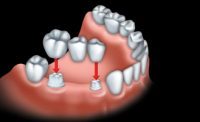Removable dental prosthesis
Solutions for damaged and/or missing teeth
There is no substitute for natural teeth and all dentists do their best to ensure that you keep them. However, sometimes one or more teeth are damaged or missing. It is possible to replace them completely or partially with prostheses, crowns or bridges. This can meet an aesthetic need and will also prevent the remaining teeth from becoming misaligned and/or causing other problems.
Here is a table that visually summarises the types of dentures, crowns and bridges.
More detailed explanations follow.
Dental prostheses
There are two types of dentures:
- Complete removable prosthesis (with or without implants)
- Removable partial dentures
These are all made in a laboratory using impressions or a mould. They need to be cleaned daily and soaked overnight, as plaque builds up on them. Plaque can lodge on the surrounding natural teeth, making them more vulnerable to decay. Dentures help with chewing and phonetic function. They also provide an aesthetic restoration.

Complete removable prosthesis
The complete removable prosthesis replaces all the natural teeth of the upper or lower jaw. It is held in place by suction. The main disadvantage is that it can shift or even dislodge entirely, which can interfere with chewing and speaking. It can be removed from the mouth for daily maintenance or for sleeping.

Example of a removable full denture

Removable prosthesis on implants
Implant-supported removable dentures (two or more implants) can also be a solution if the dentures are unstable in the mouth. The patient has less to worry about the denture falling out: he or she can eat what he or she wants and laugh without fear.
However, this choice of treatment requires several steps. Among other things, during implant surgery, several appointments are required and the bone tissue of the gums must be carefully evaluated. There is also a healing process of 2 to 4 months after the implants are anchored. The process is expensive, but the quality of life is improved afterwards.
Removable partial dentures (acrylic or metal)
The removable partial denture replaces one or more teeth. It can be removed for cleaning and overnight. The partial prosthesis prevents the migration of natural teeth into the edentulous area in the long term. It can be used when the neighbouring teeth are not strong enough to support a bridge or when too many teeth are missing.

Acrylic partial dentures
This type of prosthesis rests directly on the gums and is mainly used on a temporary basis in cases where one or more teeth are to be extracted or for an occlusal problem that needs to be corrected before a metal partial prosthesis is made. It is less stable than a metal prosthesis and can, in the long term, cause loosening of the remaining natural teeth or inflammation of the gums. The main advantage is that it is less expensive than a metal prosthesis.

The metal partial denture
Metal dentures are made with, among other things, metal clasps that hold the partial to the neighbouring teeth. The metal of the clasps, being conductive, can however increase your sensitivity to cold or heat. Also, the clasps may be visible in some cases. It is much more stable than the acrylic partial denture.

The crowns
Crowns are restorations that completely cover a single tooth, compared to dentures. They are required when a tooth is badly damaged, discoloured, deformed or devitalized after root canal treatment.
In short, when a tooth no longer has enough healthy natural tooth structure, it is necessary to make a crown as protection against further damage. This is permanently fixed to the tooth and also helps to restore the aesthetics of the tooth. There are several methods to meet your specific needs. Your Bücco dentist will be able to discuss these with you. Crowns can be made of gold, composite, porcelain or a combination of metals and dental ceramics (metal-ceramic). Generally, a crown lasts between 5 and 10 years.
Procedure for installing a dental crown
- A local anaesthetic is administered.
- A part of the tooth to be restored is removed by milling or grinding.
- An impression is taken of the tooth that has just been cut, so that the crown can be made to measure.
- A temporary crown is placed to protect the tooth until the permanent crown is ready.
- At another visit to your dentist, the temporary crown is replaced. The permanent crown is adjusted accordingly.
If the tooth is missing or needs to be extracted, it is possible to make a crown on an implant. As mentioned earlier, an implant surgery requires several steps, but the option can be interesting.
Bridges
A bridge is a fixed dental prosthesis that replaces one or more missing teeth. It consists of a minimum of three crowns soldered together. An artificial tooth or teeth rest on the adjacent natural teeth or on two implants. The teeth or implants on either side serve as the bridge’s abutments.
The main disadvantage of a bridge is that it alters the healthy teeth adjacent to the artificial tooth. The average duration of a bridge is 7 to 10 years. It should be noted that the failure of a part of the bridge may result in the loss of an abutment tooth. Loss or erosion of the cement can also result in the loss of a healthy abutment tooth.
Sometimes a dental implant and crown, although usually more expensive, is a better long-term solution and will prevent bone resorption in your mouth over the years.
Bridge installation procedure :
- The two teeth adjacent to the missing tooth are prepared to receive a crown.
- The two crowns and the replacement tooth are designed in a one-piece laboratory.
- The bridge is permanently cemented to the adjacent teeth.
Image of a traditional bridge on natural roots:

Image of a bridge on implants:


The butterfly bridge
This type of bridge is made of an artificial tooth with two metal fins (butterfly wings), which are permanently bonded to the teeth adjacent to the one to be replaced. The main advantage is that the butterfly bridge is less likely to damage the neighbouring teeth than the traditional bridge, which requires the adjacent healthy teeth to be milled.
